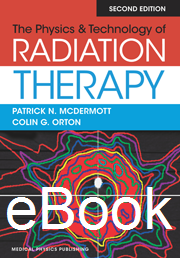
The Physics & Technology of Radiation Therapy, 2nd Edition, eBook
Author: Patrick N. McDermott and Colin G.OrtonISBN: 9781930524996
Published: November 2018 | 870 pp | eBook
Price: $ 165.00
Doody's | MAR 2019
Score: 86
The Physics and Technology of Radiation Therapy, 2nd Edition
ISBN: 978-1-930524-98-9, 870 pages, Hard Cover
Reviewer
Dimitris Mihailidis, PhD (University of Pennsylvania School of Medicine)
Description
This is the second, revised edition of a successful book on the physics of radiation therapy that covers basic principles and new technologies and how they apply to clinical practice. This edition is better organized and easier to navigate and read than its predecessor. It is designed as a parallel resource or an alternative to well-established books in the field of radiotherapy physics. The contents of this edition correlate well with the required topics in preparation for the ABR (American Board of Radiology), AART (American Registry of Radiologic Technologists), and MDCB (Medical Dosimetrist Certification Board) board examinations.
Purpose
The authors have successfully addressed the most common aspects of radiation physics from an educational and a practical perspective, while expanding into new technologies and methods of radiotherapy physics. Their book provides all the necessary information that is useful to radiation oncology residents, medical dosimetrists, and technology students. For individuals who are interested in further investigation, the reference list at the end of each chapter can greatly assist them.
Audience
Like the previous edition, this edition is directed primarily at the needs of radiation oncology residents, since it has been developed through years of experienced teaching in residency programs. It also can be useful to medical dosimetry and therapy technology students. For practitioners in the field of radiotherapy, it can serve as a great supplemental resource for those who need to practice problem-solving. I would strongly recommend this book to any radiation therapy technology training program, dosimetry program, medical residency program in radiation oncology, and to anyone who is interested in learning what new technologies and applications are available in radiotherapy physics.
Features
All of the 22 chapters include colored graphs and figures, as well as numerous tables with pertinent data and information that can be used in problem-solving. All the tables and the examples of solved equations have a colored background that makes them easily visible for better navigation. The book also includes "rule of thumb" boxes (designated by a "thumb up" symbol) within the text and a concise summary at the end of every chapter. Both of these features are valuable for review and examination preparation. Also, at the end of each chapter is a concise section of summary problems and a bibliography. The book starts with chapters on the traditional topics of radiation therapy physics and move to chapters on new technologies and modalities. Wherever pertinent, the authors underline the importance of quality control, quality assurance, and patient safety. The first two chapters review basic mathematics and physics. Chapters 3 through 6 cover atomic nuclei, radioactivity, x-ray production and technology, and the interaction of radiation with matter. Since electron beams have been routinely used in radiotherapy as an integral part of standard treatment modalities, they are covered in chapter 15, along with their dosimetry. Chapters 7 and 8 describe radiation measurement and detection methods and systems. Chapters 9 through 12 cover linac technology, photon dosimetry, photon beam calibration, calculation of monitor units, and shaped photon fields. Chapters 13 through 15 present photon dose distribution methods of computations, advanced treatment planning, including IMRT and plan evaluation. Chapters 16 and 17 cover electron beams and brachytherapy physics and applications. Chapters 18 through 21 cover radiation protection, quality assurance, and patient safety, as well as all the new technologies from imaging in radiation therapy to special modalities and special procedures and their use in the clinical setting. The last chapter is dedicated to proton therapy physics and its applications. Appendix A outlines the physics topics required by the ABR board certification for radiation oncology, the AART board certification for radiologic technologists, and the MDCB certification for medical dosimetrists. Appendix B presents tabulated dosimetry data. Appendix C provides information about the typical linac beam data, called Mevelac beam data, and Appendix D provides the answers to the problems in the book. The book is up to date and current with all the technologies and techniques seen in today's radiotherapy physics and radiation oncology practice.
Assessment
This book takes a practical approach to the application of radiotherapy physics and planning that will primarily assist radiation therapy medical residents and technologists in building their background knowledge and understanding of why and how things happen in the clinical environment. For medical residents in radiation oncology, it can serve as a quick review that incorporates all the basic definitions and recent developments in the field. Without hesitation, I would recommend this as a teaching tool for radiation therapy residencies and radiologic technology training programs. I found a clear and timely improvement with this edition because it follows the new developments in the field. It also expands upon important topics of modern clinical applications such as intensity modulated radiotherapy and imaging, treatment plan optimization and evaluation, and special procedures.


